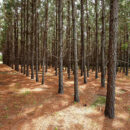FNC News
Effective Herbaceous Weed Control (HWC) for Reforestation
Herbaceous weed control (HWC) is the final reforestation practice we will discuss. HWC involves using herbicides to manage weed growth during the first year, and sometimes into the second year, to enhance the growth and survival of seedlings. Typically, HWC is applied as either a band spray or a broadcast spray between March and May.
Herbicide application reduces competition between newly planted seedlings and established herbaceous weeds and grasses. This allows water and nutrients, which would have been utilized by the herbaceous vegetation within the sprayed areas, to be accessible to the planted seedlings instead. Although first-year survival and growth still depend heavily on spring rains, summer weather, and the quality of the planting operation, it is significantly improved by this practice.
Band Spraying
Band spraying, or banding, is mostly performed in fields, pastures, and cutover sites that have little debris. A heavy debris load makes it much more difficult and dangerous for the applicators. A three- to four-foot-wide band of herbicide is sprayed over the top of planted pine seedlings using ATV’s, backpack sprayers, or retrofitted skidders. The skidders are equipped with rear-mounted spray tanks and booms with adjustable nozzles. ATVs with rear-mounted tanks are also commonly used. Backpack sprayers are sometimes used when acreage, tract location, or other factors make the use of other equipment impractical.
Broadcast Spraying
Broadcast spraying, also known as aerial spraying, is typically accomplished by helicopter with accompanying fuel and chemical support trucks. Boundaries for the treatment area are generally delineated and then used to create a shapefile (map), which is uploaded to a Global Positioning System (GPS) unit in the helicopter. A suitable location for helicopter landing, refueling, and refilling the chemical tanks is also located on the property or within a reasonable distance from the property. Recently, drones have also been used to apply HWC. Their payload is much less than a helicopter, but there is also a much lower risk of the herbicide drifting onto a neighboring property.
Herbicide Selection
Herbicides are site-specific. Many factors determine which treatment is best suited for a particular purpose on a given site. These factors include the type of unwanted vegetation to be controlled, species of planted seedlings or remaining trees, age of seedlings or remaining trees that will be oversprayed, soil type, time of year, proximity to streams or drains, sensitivity of surrounding areas to damage from herbicides, and cost. All these factors influence the suitability and efficacy of a herbicide for a particular site.
Interested in learning more about HWC? Contact a Farmers National Company Forester today to discuss your specific site needs.
More News
Get in Touch




